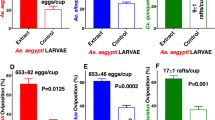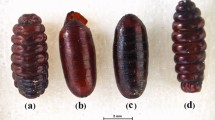Abstract
THE protection afforded to sheep against blowfly strike by the new synthetic chlorinated hydrocarbon insecticides applied to the fleece has been shown to be the result of two different actions. Insectary tests have demonstrated distinct repellent effect and the prevention of oviposition in the case of gravid female flies, whereas implantations of first instar larvæ, according to the method of McLeod (1937), have indicated the larvicidal role.
This is a preview of subscription content, access via your institution
Access options
Subscribe to this journal
Receive 51 print issues and online access
$199.00 per year
only $3.90 per issue
Buy this article
- Purchase on Springer Link
- Instant access to full article PDF
Prices may be subject to local taxes which are calculated during checkout
Similar content being viewed by others
Author information
Authors and Affiliations
Rights and permissions
About this article
Cite this article
FIEDLER, O., DU TOIT, R. A New Biological Method for Evaluating the Efficiency of Insecticides for the Protection of Sheep against Blowfly Strike. Nature 168, 608–609 (1951). https://doi.org/10.1038/168608b0
Issue Date:
DOI: https://doi.org/10.1038/168608b0
This article is cited by
Comments
By submitting a comment you agree to abide by our Terms and Community Guidelines. If you find something abusive or that does not comply with our terms or guidelines please flag it as inappropriate.



